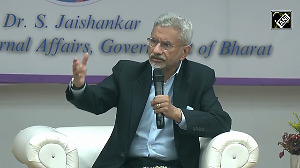When a chit of a boy, just 13 years of age, and with parents in tow, hesitantly walked into St Joseph's Boys School principal Fr Dennis Coelho's office two decades ago to seek permission to skip classes for a few days, little did any of them guess that they were at the crossroads of history.
"Rahul had been selected to play for Karnataka in the South Zone under-15 cricket tournament in Andhra Pradesh. His school was always more concerned with academics. We did not think they would allow him to skip classes for 15 days. We went with Rahul to meet the principal to tell him that we would comply with the school's regulations," said
Sharad Dravid, Rahul's father.
"I don't remember the minute details but the Dravids have spoken to me about it subsequently," Fr Coelho modestly recalled of that distant day.
"When we said Rahul would attend school rather than go to Andhra for the tournament, Fr Coelho said, 'No. Let him go and play. He is embarking on a great adventure. Schooling can wait.' The minute he said that, Rahul screamed with joy and leapt in the air," said a beaming Sharad Dravid.
Well, that great adventure he embarked on 20 years ago is still a work in progress. En route, though, the shy, withdrawn but earnest lad, has metamorphosed into one of the toughest cricketers in world cricket. His impeccable technique no doubt thwarts the best of rival bowlers.
That, coupled with his sheer mental toughness that simply wears down opponents.
In a nation mesmerized by the willow wizardry of Sachin Tendulkar and the bludgeoning aggression of Virender Sehwag, Dravid's stupendous prowess is not apparent to the gallery. But those in the know readily acknowledge his matchless qualities.
When working on Dravid's biography, I met a number of players, administrators, teachers, coaches, etc who spoke glowingly of Dravid's temperament and mental strengths. But the real gem of an observation came from the then Indian team coach John Wright: "When Rahul does well, India do well. Sachin is Sachin. But in all conditions Rahul is The Man." To this day, when the stylish batsman has reached the pinnacle of his career as undisputed captain of the Indian cricket team, that fact has not changed.
The fact that Dravid has the best average among contemporary batsmen and that his overseas batting average is healthier than his healthy average at home, and that he has the best average in Tests won by India are all too well known to bear repetition here. I will simply dwell on the making of the man the world calls `The Wall.'
Dravid's remarkable ability from a very young age was converting disadvantages into opportunities. The Bangalore of his youthful days did not boast of too many turf pitches. Almost all matches at school, college, club and even senior division league level were all played on coir matting pitches. Batting on these pitches had many disadvantages. It was not the most conducive of pitches to hone your skills as a batsman. But on the plus side, the bounce on these pitches would be higher. The batsmen had to reckon with this all the time.
"While that was a great initiator to work on my backfoot play, the best advice during my early years came from Javagal Srinath who was already an India international. He said that in international cricket I wouldn't get too many opportunities to drive the ball off the front foot. So I had to develop backfoot strokes, especially the pull, hook and cut if I wanted to make a mark," said Dravid.
For Dravid, working on these strokes came easy. He already had them in his repertoire. He just needed to hone them. He sought fast bowlers who could test him in the nets. He was lucky that around that time Karnataka were blessed with a string of outstanding fast-medium bowlers in Srinath, Venkatesh Prasad, David Johnson, Nassiruddin, Mansoor Ali Khan, Dodda Ganesh, et al. Barring Johnson, the rest of them were all very tall.
But the relatively short and volatile Johnson was the real character in this bunch. He could be explosive with both temperament and with the ball. He was quick, quicker than even Srinath. He hated batsmen and made it known repeatedly. He went after them even in the nets, often bowling from 20 yards. None of the batsmen were comfortable against him in the confines of nets. But Dravid took it as a challenge to wear him down. The Karnataka cricketers speak in awe of the way the young Dravid would look Johnson in the eye and urge him to give it his best shot. Even as the fast bowler would let fly, Dravid made every session count by gaining something out of it. He would ask the bowlers for their imaginary field placements and concentrate on each and every delivery. Bowlers who dared fool around while he was batting would get a mouthful. Soon everybody realized that he was a man with a mission and they too could gain if they adhered to his work ethics.
If this was not enough, Dravid would then indulge in some real serious mock batting. He would take strike on KSCA Stadium's lower tier pavilion rack and have another cricketer throw a wet cricket ball from a higher step. This would replicate the steep bounce that he could expect in Australia and South Africa. Initially he would take stance without a bat in hand and concentrate only on weaving in and out of line of the skidding tennis ball. Later, he would use a willow to defend. The wet tennis ball, hurled from about 10 to 12 yards would skid and climb alarmingly. But Dravid would always be in a position to defend it or weave out of line. This sort of meticulous preparation has always kept him one step ahead of the opposition bowlers.
Prior to the previous tour to Australia, he found that the Australian batsmen used willows which felt different. "I picked up a bat and the balance was a bit strange. On enquiry I found that the sweet spot of their bats were higher, to compensate the greater bounce on their pitches," said Dravid.
He quickly flew down to his bat manufacturer and ordered similar sticks believing that they would help him on the tour Down Under. He carried the bats with him and tried it out in the nets. "But I did not play with them. I was very uncomfortable with their feel. So I opted to stick to my usual bats," said Dravid. The point to be made here is that he did not miss a trick in the book. He had stated before the tour that to be accepted as a top batsman he had to score runs in Australia. That was the litmus test, he insisted, and was willing to do whatever it took to succeed there.
On that tour, Dravid made tons of runs, including those crushing marathon knocks at Adelaide where his 305 runs from the two innings occupied a total of 835 minutes and demoralized the Aussies. Dravid, no doubt, used his standard willow in authoring India's historic win.
However, if he had found that his willows were not getting him anywhere, he was ready to chuck them and try out the `Aussie' bats.
It is not just equipment or his preparation for a series that makes Dravid The Wall. His run-up to a Test is as fascinating. He prepares for it with great detail and clarity. Contrary to popular belief, he eases off on nets practice a couple of days prior to a Test. After that it is all mind games.
He studies the pitch, the opposition bowlers, looks at their tapes, his knocks against them and starts replaying in his mind his best stints against them. He tries to work out the opposition's strengths and weaknesses.
Dravid then eases off totally and slows things down as much as possible. He takes leisurely lunches and dinners, long baths and generally slows down the pace of everything he does. He ensures that he never has to hurry. This way he slowly gets into what he believes is the right frame of mind and pace for a five-day Test.
The night before the game he visualizes the game, how he'd want it to go and how he would play it. He gets to the ground early and soaks in the atmosphere. He does not get into the game too deeply as he prefers to expend his mental energies when he is out there in the middle.
While batting, he shuts out negative thoughts as much as possible by focusing instead on the ball. Once his concentration levels are high he seeks to get into the zone where it is just the ball and him. He seeks to blank out everything else and just focus on the delivery that he is about to play. He sets small targets and then concentrates on batting through sessions, second or third new ball, end of play, and so on.
Sooner or later, the bowlers, worn down by his relentless grinding, feed him deliveries that he feels comfortable to score off. Yet another battle is won.
His methods may seem simple. But they are a tremendous test of character and self-confidence. He has to back himself and his ways to the hilt without entertaining the slightest doubt. And only when he has come out trumps does he ease off.
All along, while he is the pillar of the line-up, the others, Tendulkar, Sehwag, et al go for their strokes confident that Dravid will keep his end going. So what if they seem more explosive or strokeful or attractive. At the end of the day champion is what champion does. A 100 Tests and a stunning average later, Dravid is just that India's champion cricketer.
Vedam Jaishankar is Rahul Dravid's biographer and author of the book Rahul Dravid a Biography. He is currently Managing Editor of Bangalore Bias, a Bangalore-specific weekly newspaper







 © 2025
© 2025